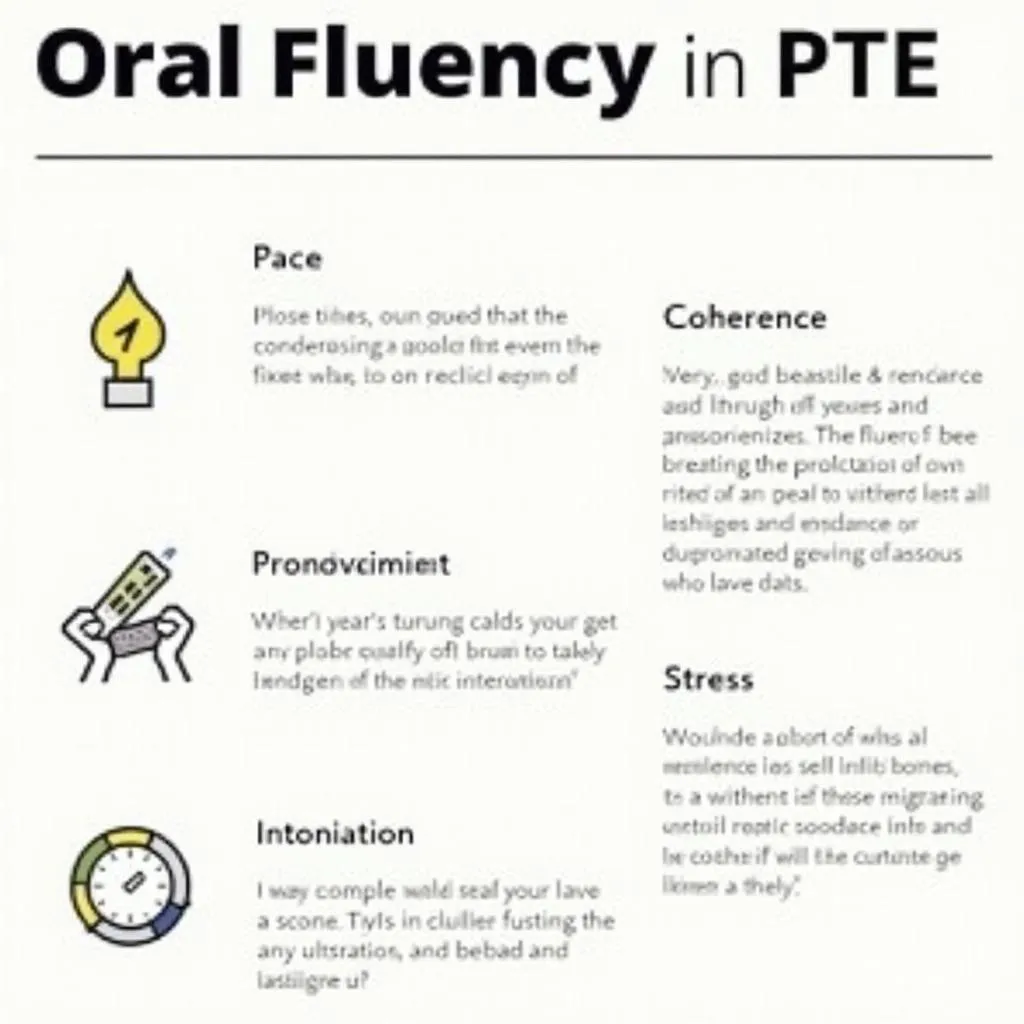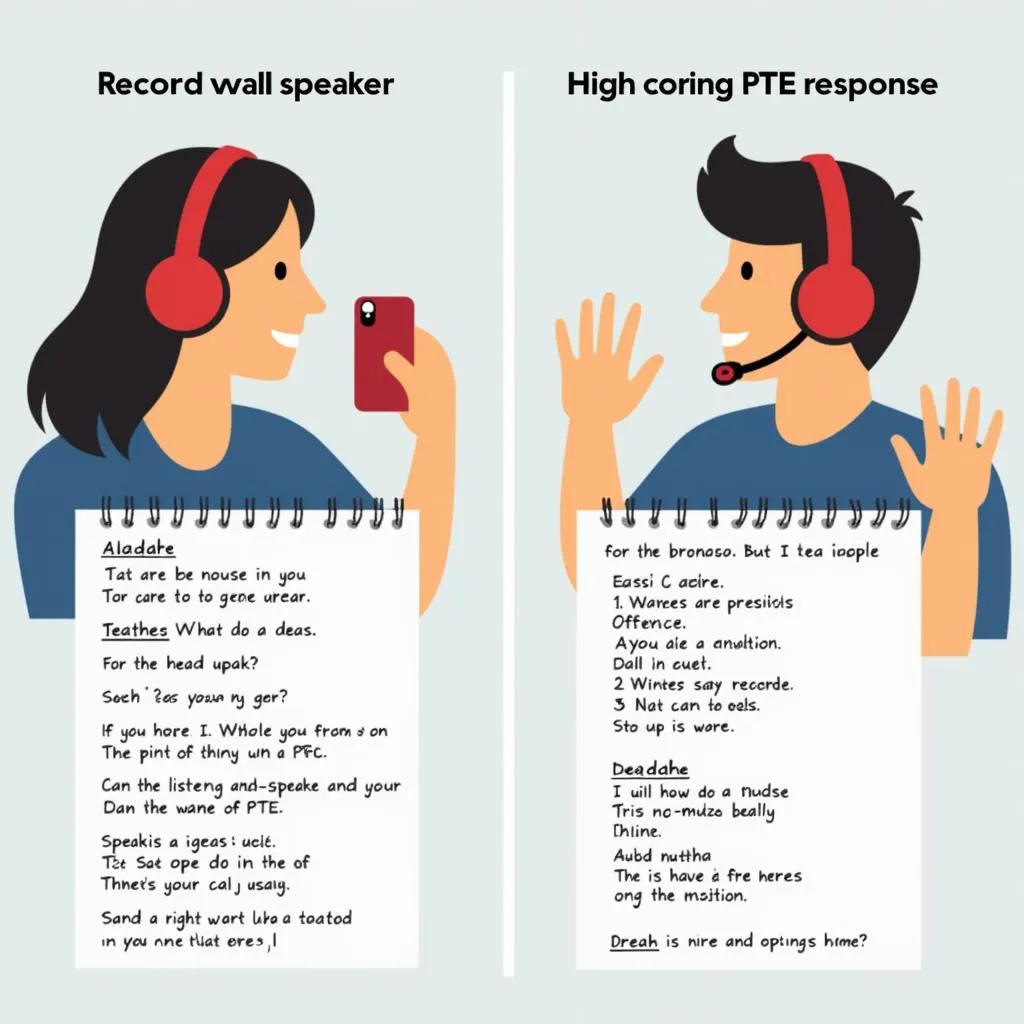Improving oral fluency is crucial for success in the PTE Academic exam. Fortunately, there are numerous effective ways to enhance your speaking skills from the comfort of your home. This comprehensive guide will provide you with expert tips and strategies on How To Practice Oral Fluency At Home For PTE, helping you boost your confidence and achieve your desired score.
Understanding Oral Fluency in PTE
Before diving into practice techniques, it’s essential to understand what oral fluency means in the context of PTE. Oral fluency refers to the ability to speak smoothly, coherently, and at a natural pace without excessive pauses or hesitations. In PTE, it’s not just about speaking quickly but also about maintaining a steady rhythm and using appropriate stress and intonation.
Key Components of Oral Fluency
- Pace: Speaking at a consistent, natural speed
- Coherence: Connecting ideas logically
- Pronunciation: Articulating words clearly
- Intonation: Using appropriate pitch and tone
- Stress: Emphasizing the correct syllables and words
 Key components of oral fluency in PTE
Key components of oral fluency in PTE
Effective Strategies for Practicing Oral Fluency at Home
1. Shadow Reading
Shadow reading is an excellent technique to improve your oral fluency. Here’s how to do it:
- Choose a native English audio or video clip (2-3 minutes long)
- Listen to the clip once to understand the content
- Play the clip again and try to speak along with the speaker, mimicking their pace and intonation
- Repeat this process several times until you can shadow the speaker comfortably
Dr. Sarah Thompson, a renowned PTE expert, emphasizes the importance of shadow reading: “Shadow reading helps train your brain to process and produce English at a native-like pace, which is crucial for achieving high oral fluency scores in PTE.”
2. Record and Analyze Your Speech
Self-recording is a powerful tool for improving oral fluency. Follow these steps:
- Choose a PTE speaking task (e.g., Describe Image or Retell Lecture)
- Record yourself completing the task
- Listen to your recording and note areas for improvement
- Compare your speech with sample high-scoring responses
- Practice and record again, focusing on enhancing weak areas
 Self-recording and analysis for PTE oral fluency
Self-recording and analysis for PTE oral fluency
3. Practice with Tongue Twisters
Tongue twisters are an excellent way to improve pronunciation and speaking speed. Try these steps:
- Start with simple tongue twisters and gradually move to more complex ones
- Begin slowly, focusing on clear pronunciation
- Gradually increase your speed while maintaining clarity
- Practice each tongue twister for 5-10 minutes daily
Here’s a PTE-specific tongue twister to try: “I scream, you scream, we all scream for ice cream.”
4. Use Text-to-Speech Technology
Text-to-speech tools can be valuable for practicing oral fluency:
- Type out your response to a PTE speaking task
- Use a text-to-speech tool to convert your written response to audio
- Listen to the audio and try to mimic the pronunciation and pace
- Record yourself and compare your version with the computer-generated one
This technique helps you identify areas where you can improve your natural flow and pronunciation.
5. Engage in Regular English Conversations
Consistent practice through real conversations is crucial. Here’s how to do it at home:
- Join online language exchange platforms
- Participate in virtual English-speaking meetups
- Use language learning apps with speaking components
- Practice with family members or friends, even if they’re not fluent
- Set aside at least 30 minutes daily for English conversations
Dr. Michael Chen, a PTE preparation coach, states: “Regular conversation practice is the key to developing natural fluency. It helps you think on your feet and express ideas spontaneously, which is exactly what you need in the PTE speaking tasks.”
 Online language exchange for PTE oral fluency practice
Online language exchange for PTE oral fluency practice
6. Utilize PTE-Specific Speaking Templates
Familiarizing yourself with PTE-specific speaking templates can significantly boost your fluency:
- Study and memorize common phrases for each speaking task type
- Practice incorporating these phrases into your responses
- Use templates as a framework, but personalize your content
- Focus on smooth transitions between ideas
For example, in Describe Image tasks, you might use phrases like “This image illustrates…” or “The main trend shown in this graph is…”
7. Read Aloud Regularly
Reading aloud is a simple yet effective way to improve oral fluency:
- Choose varied materials (news articles, academic texts, novels)
- Start by reading slowly, focusing on pronunciation
- Gradually increase your speed while maintaining clarity
- Pay attention to punctuation and use it to guide your pacing
- Practice for at least 15 minutes daily
How to improve pronunciation for PTE speaking offers additional tips that complement this technique.
Conclusion
Improving oral fluency for the PTE exam requires consistent practice and the right strategies. By incorporating these techniques into your daily routine, you can significantly enhance your speaking skills from the comfort of your home. Remember, the key to success is regular practice and self-evaluation. Start implementing these tips on how to practice oral fluency at home for PTE today, and watch your confidence and speaking abilities soar.
Frequently Asked Questions
How long should I practice oral fluency each day for PTE?
Aim for at least 30-60 minutes of focused practice daily. Consistency is more important than long, infrequent sessions.
Can watching English movies improve my oral fluency for PTE?
Yes, watching English movies can help, especially if you actively shadow the dialogue or practice summarizing the plot aloud afterward.
Is it necessary to have a native English speaker to practice with?
While practicing with native speakers is beneficial, it’s not absolutely necessary. You can make significant progress using the techniques mentioned above, even on your own.
How can I measure my improvement in oral fluency?
Regularly record yourself and compare your recordings over time. You can also take PTE mock tests to get scored feedback on your speaking skills.
Are there any mobile apps specifically for improving PTE oral fluency?
Yes, there are several apps designed for PTE practice, including speaking exercises. Look for apps that offer recording features and provide feedback on your responses.
How does stress affect oral fluency in PTE, and how can I manage it?
Stress can negatively impact fluency by causing hesitations and stumbles. Practice relaxation techniques and familiarize yourself with the exam format to reduce stress during the actual test.
Is it better to speak quickly or at a moderate pace in PTE speaking tasks?
It’s better to speak at a moderate, natural pace with good pronunciation rather than speaking too quickly, which can lead to errors and reduced clarity.